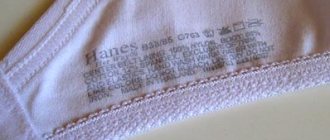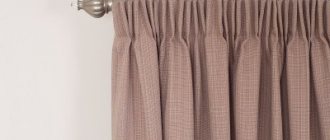How often should bed linen be changed?
Every day we spend 6-8 hours in bed, during this period there is a gradual accumulation of sweat and dirt, which is often added by pets. All these factors lead to the proliferation of pathogenic bacteria and the appearance of small mites that live in pillows, blankets and mattresses.
The frequency of changing bed linen and washing it depends on the time of year. In summer you need to completely remake the bed every week; in winter you can do this less often, once every 10-12 days. Fresh linen will improve the quality of your sleep and make your rest complete and safe for your health.
More frequent washing of bed linen and exposure to powder destroys the structure of the fibers and washes out the color. Experts recommend cleaning fabrics at a temperature of 60-70 °C.
Drying
Not every housewife in the city can afford to hang bed linen on lines - many apartments lack such an important element as a balcony. The only way out of the situation is machine drying.
Advice : it is better not to hang bedding on hot radiators - the fabric may be damaged and will obviously dry out, becoming rough.
How often to wash underwear
Regardless of cleanliness and freshness, clothing that comes into contact with our body must be changed daily, this is especially true in the summer, but there are exceptions.
If things have just been purchased, are tightly packed and look clean, washing is mandatory, because you do not know under what conditions they were made and stored.
Underwear change schedule:
- the bra can be worn 3-4 times before washing, but you should not wear the same bra every day, it is advisable to change it every two days;
- panties require regular changes, underwear needs to be refreshed after each dressing;
- socks and tights cannot be reused, especially for children's items;
- thermal underwear must be refreshed after 2-3 wearings and strictly follow the recommendations and rules for washing thermal underwear, otherwise the fabric may lose its heat-saving function;
- Pajamas need to be changed and washed twice a week.
Advice. Underwear is often made from delicate fabrics that require proper handling. Experts recommend washing things at a temperature of 40-50 °C and without strong spinning, then they will retain their shape, color and beautiful appearance for a long time.
Bra: after every second wear
Kelly Dunmore, lingerie expert at Rigby & Peller, insists that you should wash your bra after you've worn it twice, or three at most. “The bust area and especially the armpits are an inexhaustible source of sebum and sweat.”
Difficulties await us here: it is not recommended to wash bras in a machine, since this destroys the elasticity of the fabric fibers and reduces the life expectancy of expensive underwear: with proper care, the bra should last at least a year.
So the underwire miracle needs to be washed by hand and then dried at room temperature, spread on a towel: the heat of a radiator or dryer destroys the lycra.
How often to refresh tulle and curtains
The fabric accumulates dust, but does not need frequent washing. The frequency of refreshing tulle and curtains depends on the room in which they hang and the time of year.
We recommend: The washing machine stains the clothes – is it your fault or is it her fault?
In winter, there is less dust in the air than in summer, and you can not remove textiles from the window, but limit yourself to processing with a steam generator and a hand-held vacuum cleaner. This will remove accumulated dirt, unpleasant odors and freshen the curtains. The exception is textiles in the kitchen, which often get dirty, but it is advisable to wash tulle and curtains in this room at least 5-6 times a year. This will protect the fabric from stubborn dirt, which is very difficult to remove.
In summer, dust from open windows accumulates more intensely in curtains and tulle, so it is recommended to wash textiles once every 2-3 months. If you do not wash regularly, the risk of respiratory diseases and allergies increases, especially if there are small children living in the house.
Advice. It is recommended to wash curtains and tulle at a temperature of 30-40 °C without spinning. To avoid ironing the fabric, let the water drain and hang the textile on the windows slightly damp; under the influence of its own weight it will straighten out and will not look wrinkled.
Knitted tights
Like underwear, this wardrobe item needs to be washed daily. But as practice shows, many girls can wear the same tights for weeks until they tear or wear through holes. However, this is a big mistake. Knitwear, like socks, absorbs sweat, which creates ideal conditions for the proliferation of pathogenic microflora. As a result of this, very often representatives of the fair sex who do not take care of their hygiene develop a fungus, which is not as easy to cure as many people think. There is also a risk of developing such a serious dermatological disease as erythrasma. It is much easier to wash your tights every day and not have any problems.
Frequency of washing bath and kitchen towels
Fabrics that are constantly in contact with our hands and body and often get wet can be a source of intestinal infections. If the towel is dried after a shower and can be changed once a week, then kitchen utensils need to be washed much more often.
Cooking and constantly drying hands after washing is a humid environment, which is favorable conditions for the growth of bacteria. To avoid diseases, experts recommend washing kitchen towels 2-3 times a week.
Recommended temperature is 60 °C for colored fabrics and 80-90 °C for white fabrics. If there are severe stains, then the kitchen towels must first be soaked for 2-3 hours and then put into the washing machine.
Telephone: daily
Research has shown that on average we touch a mobile phone 150 times a day, and American scientists found 7,000 different types of bacteria in fifty-one “tests” taken from phones. Some of these bacteria are harmless, but only some are.
“As you use your phone, it heats up, creating the perfect environment for bacteria to grow,” says Laura Bowater, a microbiologist at the University of East Anglia. — Enterococcus (fecal bacteria) and Pseudomonas aeruginosa are serious pathogens, and both have been found on the surface of phones. The worst models are those with a keyboard, due to the thin gaps between the keys. So you need to clean your phone daily using antibacterial wipes.”
How often should you wash jeans?
Wear-resistant and durable fabric does not require special care. Clothing manufacturers recommend washing jeans no more than once a month, provided there are no heavy dirt or stains.
We recommend: We wash a newborn baby’s clothes with powder, soap, in a machine, by hand... Which is better?
Features of caring for denim clothing:
- You should not subject things to regular wetness if you wear them rarely and wear them irregularly. This causes the color to be lost and the structure of the fabric to deteriorate.
- Wash jeans inside out; you also need to dry the item, preferably in a horizontal position.
- Do not use powders with a bleaching effect on dark-colored clothing.
- Washing temperature for denim is no more than 40 °C without spinning. To dry, you need to let the water drain and hang the pants with the zipper fastened by your waistband or lay them out on a table or other horizontal surface covered with a towel.
If you follow simple rules, you can keep your jeans in their original form and wear them for many years.
Sweaters
If you wear a shirt or T-shirt under a sweater, you can wear the latter six times or more before it needs to be washed. To maintain the shape and quality of your sweater, be sure to follow the care instructions on the tag. Sometimes it may be necessary to hand wash or set the washing machine to a delicate cycle. If you are worried that you might ruin an expensive item, it is better to take the sweater to the dry cleaner.
The developer of CoviVac confirmed the possibility of revaccination with the drug
How to feed crocuses in March so that in April you will be pleasantly surprised by their flowering
Anabolic State: Defining Common Fitness Terms
However, if you sweat a lot or wear the sweater naked, you will need to wash it after one or two wears. Also, be sure to check the neckline, cuffs, and elbows every time you wear them to make sure they are clean.
How often to wash outerwear
Jackets, down jackets and raincoats should not be wetted frequently, this is especially true for items with fur and down; the insulation partially loses its properties when exposed to water and powder.
Experts recommend refreshing seasonal clothes once every three months, but if you don’t have washing experience, it’s better to take them to the dry cleaner.
When refreshing a jacket or down jacket at home, it is better to soak them in a mild detergent in water at a temperature of 20-30 ° C for 30 minutes. Gently rub the stained areas by hand, rinse and let the water drain without spinning. It is better to dry such things on hangers, away from sunlight.
What items are best to take to the dry cleaner?
Not all types of clothes can be washed at home. It is better to clean individual specimens with professional products. Among them:
- evening dresses;
- blouses made of natural silk, chiffon, viscose;
- shirts and t-shirts with prints made using the “Fabric Painting” technique;
- pleated skirts;
- business suits (dry cleaning will preserve their severity);
- jackets and dresses embroidered with beads or sequins;
- jumpers and sweaters made of hand- or machine-knitted wool;
- raincoats, jackets, coats with lining;
- down jackets;
- clothes made of suede, genuine leather, fur.
Do I need to wash soft children's toys?
Teddy bears and bunnies can be dangerous for children. The fabric accumulates dust and dirt, where germs multiply, so it is necessary to wash them. If the manufacturer does not recommend getting their products wet and this is a child’s favorite toy, then you can place it in the freezer for 2-3 days.
If washing is possible, it is recommended to soak the bunny or bear in warm water with baby powder or gel for 2-3 hours, gently wash by hand and rinse thoroughly.
Knowing the basic recommendations on the frequency of washing things, you can create an approximate operating schedule for the machine. At the same time, you save water, electricity and keep the fabric in good condition.
Casual pants
If you work in an air-conditioned office, you need to have two or three pairs of casual work pants. Be sure to hang them up after each wear and leave them on for 24 hours. This will allow the fibers to relax and the item will serve you for a long time. If your trousers wrinkle a lot after each wear, you can lightly wet the fabric and iron the wrinkled areas.
We bake a whole basket of “mushrooms”: we take a plastic bottle to help
He works in a women's team: types of men prone to cheating in relationships
Russians were reminded of the end of “coronavirus” benefits on April 1
Storage
Methods for saving bed linen when it is not used for its intended purpose differ, but have a general classification.
On shelves, in stacks:
- This is what most housewives do: just put clean, ironed and folded laundry on top.
- A separate type classification (pillowcases, sheets, duvet covers) or color classification is practiced. The disadvantages include the difficulty of getting an item from the bottom of the stack - you will have to disturb it all. Often there is a need to sort out the upper elements that lie unevenly.
- The problem can be easily solved if the bed linen is complete: the rest of the set components are collected in the pillowcase.
- On hanging shelves.
- The compact fabric shelf has proven itself to be excellent for storing linen not in closets, but, for example, in pantries.
- It is convenient to combine by type, color or any other sorting method.
In chests of drawers and drawers:
- Compact and convenient. Similar to storing on shelves in a closet.
- The visibility gets worse and sometimes you have to go through the entire stack to find and get the right thing.
- If the laundry is lying very closely, if stored for a long time and high humidity in the room, it can fade, become damp, and become moldy.
- When there are few things, they are stored in a drawer of the closet - excellent ventilation, and everything is visible.
Rolls on shelves:
- Very original, but costly and impractical.
- Relevant for storing in boxes or furniture organizers, when you need to take it out not from the side, but from the top.
- It doesn’t always look pretty - you get the feeling that things are just thrown together in a heap.
- There is a chance that the remaining rolls will unwind if you take one out.
In containers:
- Saving bed linen in special plastic containers, vacuum bags, organizers or shaped fabric containers with mesh “windows” is convenient and practical.
- Dust does not settle on the fabric.
- Looks beautiful anywhere you store it.
- It is convenient to sort according to the accepted methodology.
Each housewife needs to decide for herself how it will be convenient to store laundry in a particular case.
Tip : next to other things of the same type, the differences are immediately visible and it becomes clear how often you need to change old bedding for new ones. This is done as it wears out.











